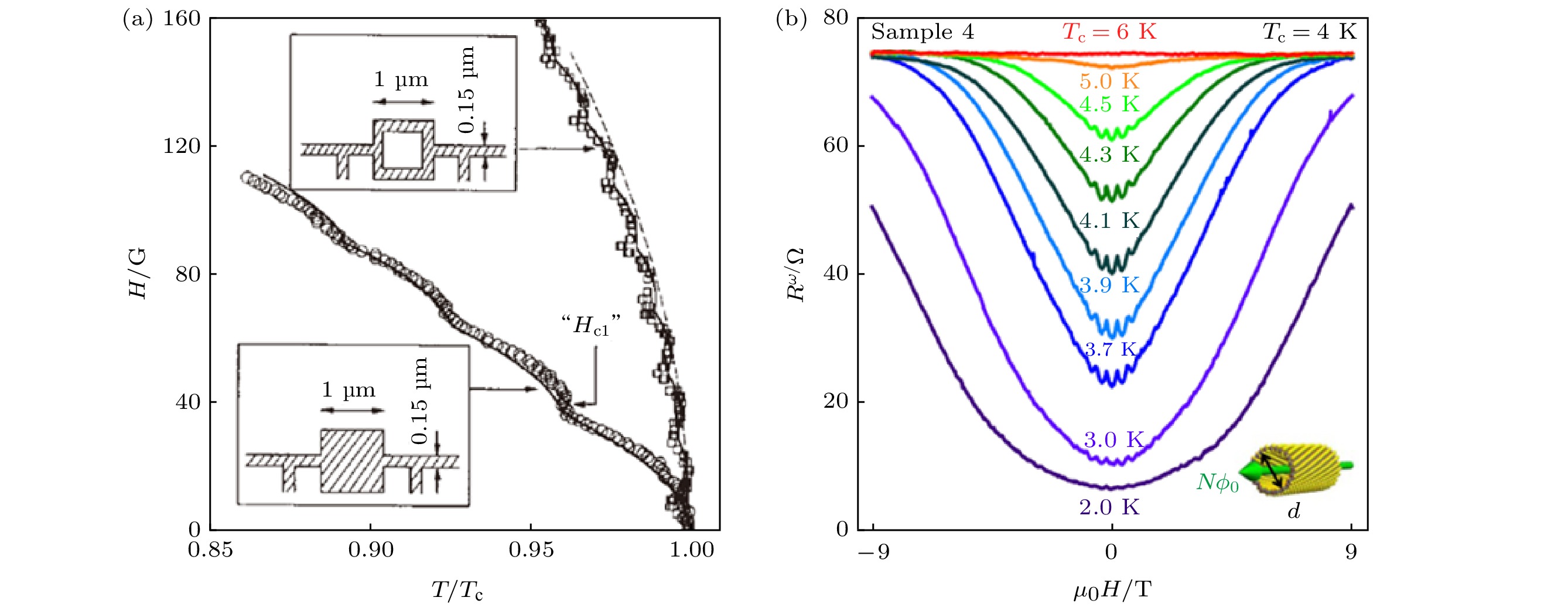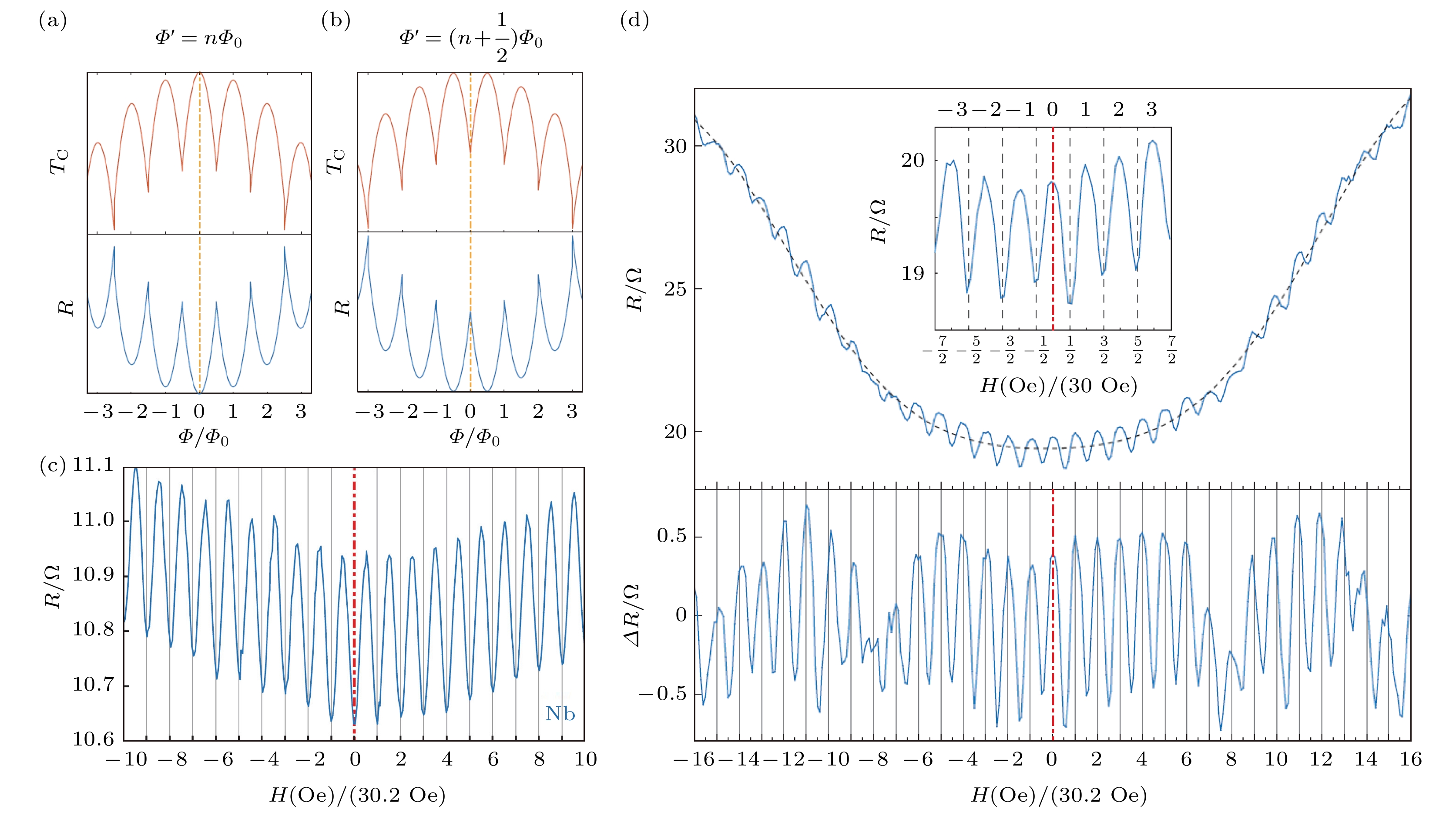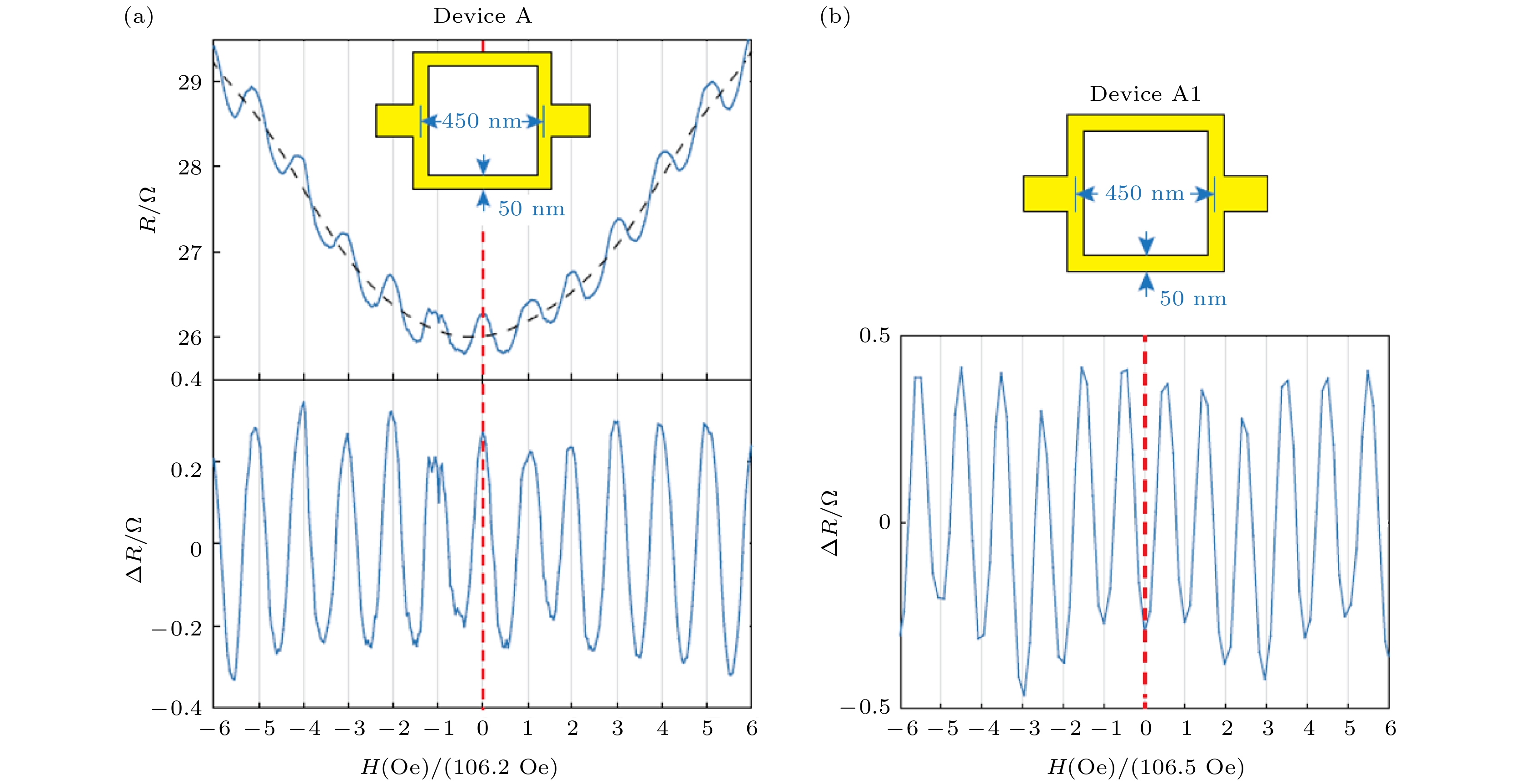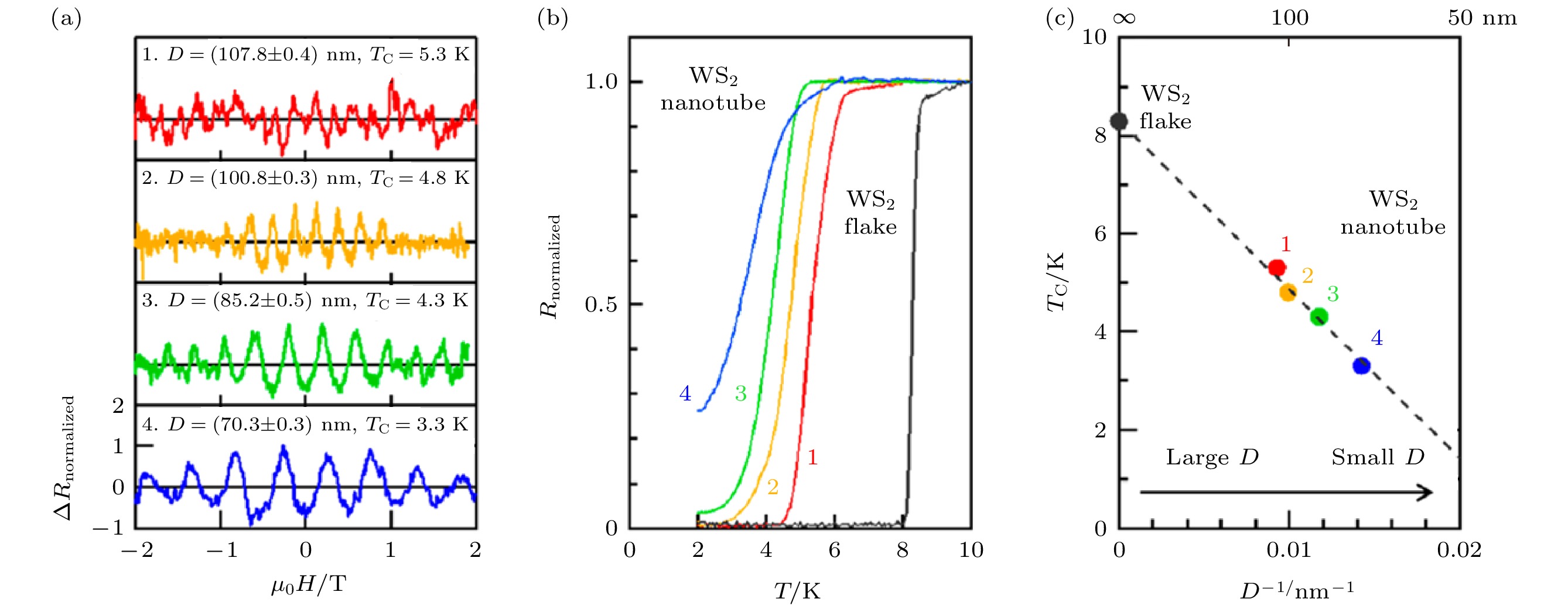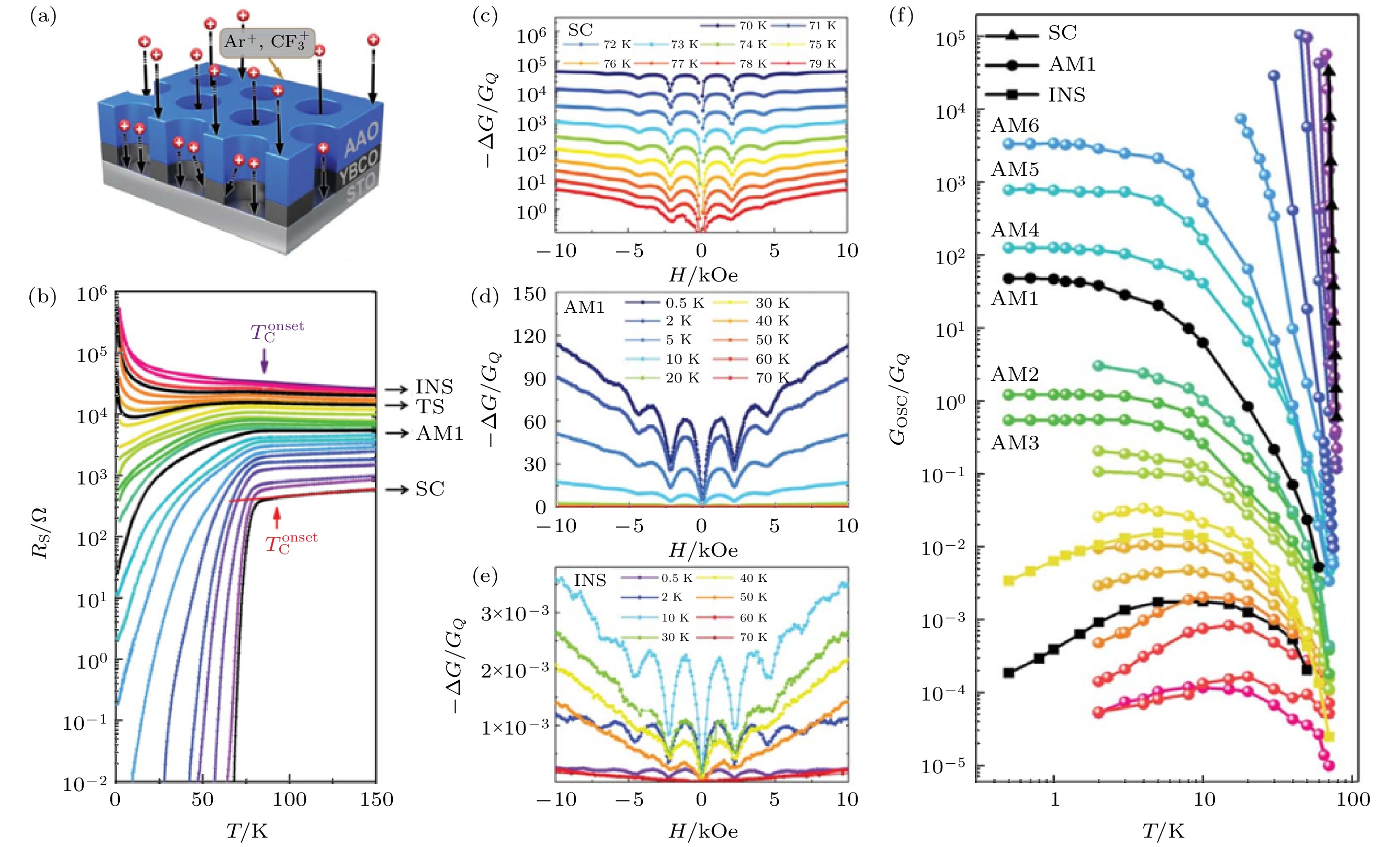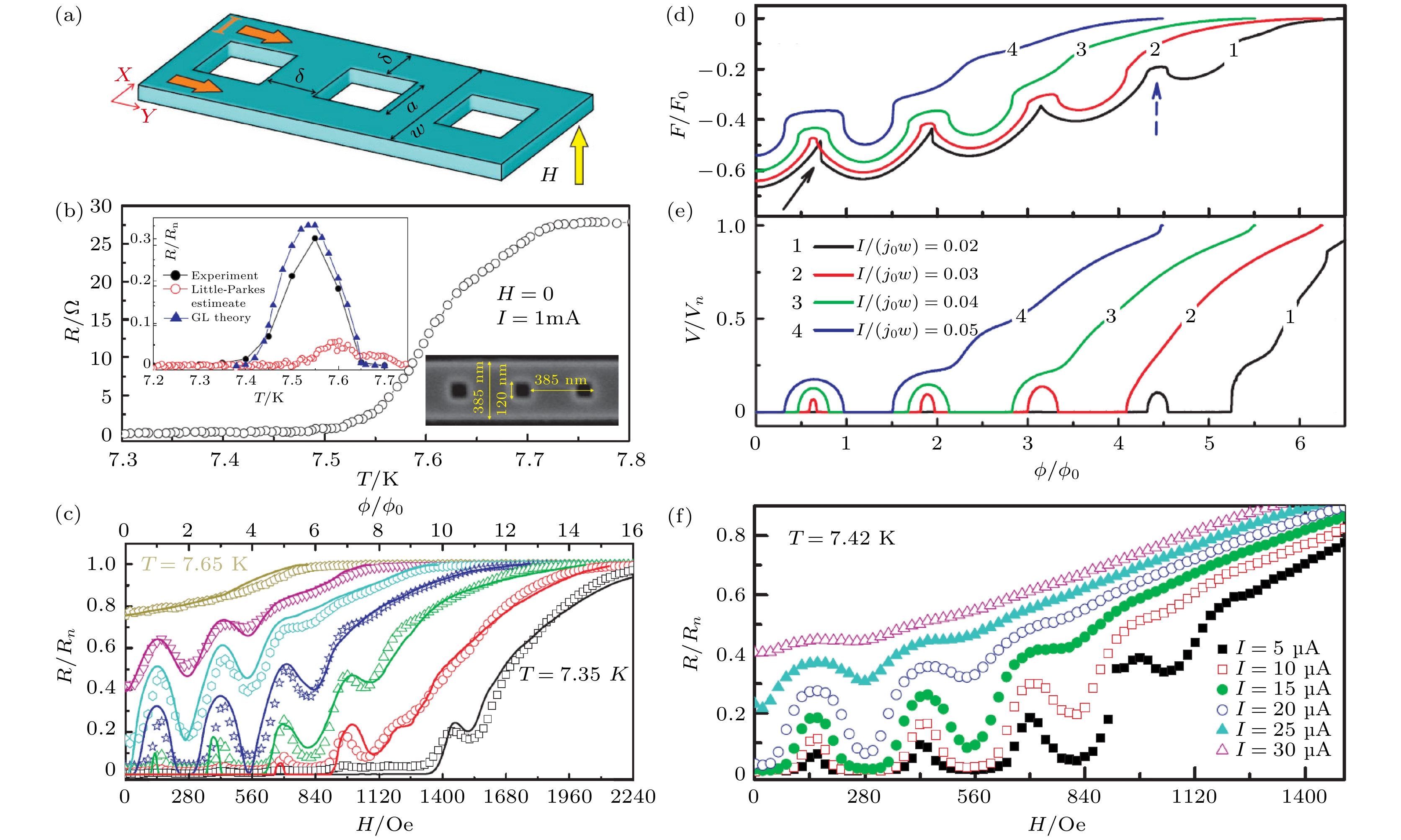-
低维超导材料由于具有尺度接近量子临界尺寸的优势, 能够观测到显著的超导量子振荡效应, 因此成为研究超导量子振荡效应的优异平台. 由于这些量子振荡效应的周期、振幅、相位与磁通涡旋的量子化及运动方式、超导电子的配对机制、特定外部条件下超导体中的涨落和激发现象密切相关, 并且它们还能直观地反映超导材料的几何结构对其超导物性的影响, 因此对低维超导体中振荡效应的研究直接反映了超导体的本质规律, 成为研究材料超导机制的一种重要手段, 有着深邃的物理内涵和丰富的研究价值. 本文将探讨三类能够在低维超导材料中观测到的典型超导量子振荡效应: 利特尔-帕克斯效应、磁通涡旋运动导致的振荡效应和韦伯阻塞效应, 从研究手段、理论预期、实验现象以及实验结果诸方面综述其中所揭示的深刻物理规律, 并展望低维超导体的量子振荡效应在量子计算、器件物理和低温物理等领域的应用价值.
Low-dimensional superconductor serves as an excellent platform for investigating emergent superconducting quantum oscillation phenomena. The low-dimensional natures of these materials, originating from the finite size which is comparable with the superconducting coherence length, indicate that the corresponding physical properties will be constrained by quantum confinement effects. Importantly, some of the frontiers and hot issues in low-dimensional superconductors, including the anomalous metal state during the superconductor-insulator transition, spin-triplet pairing mechanism in superconductors, thermal-excited and electrical current-excited vortex dynamics in superconductors, and the “charge-vortex duality” in quantum dot materials and superconducting nanowires, are strongly correlated with the superconducting quantum oscillation effects. In recent years, all the above-mentioned topics have achieved breakthroughs based on the studies of superconducting quantum oscillation effects in low-dimensional superconductors. Generally, the periodicity and amplitude of the oscillation can clearly demonstrate the relation between the geometric structure of superconductors and various superconducting mechanisms. In particular, superconducting quantum oscillation phenomena are always correlated with the quantization of magnetic fluxoids and their dynamics, the pairing mechanism of superconducting electrons, and the excitation and fluctuation of superconducting systems. In this review article, three types of typical superconducting quantum oscillation effects observed in low-dimensional superconductors will be discussed from the aspects of research methods, theoretical expectations, and experimental results. a) The Little-Parks effect is the superconducting version of the Aharonov-Bohm effect, whose phase, amplitude and period are all helpful in studying superconductivity: the phase reflects the pairing mechanism in superconductors, the amplitude can be used for investigating the anomalous metal state, and the period provides the information about the sample geometry. b) The vortex motion effect is excited by thermal fluctuation or electrical current, and the corresponding oscillation phenomena show distinct temperature-dependent amplitudes compared with the Little-Parks effect. c) The Weber blockade effect originates from the magnetic flux moving across the superconducting nanowire, and such an effect provides a unique nonmonotonic critical current $ {I}_{\mathrm{C}} $ under a magnetic field in$I\text{-}V$ characteristics. The prospects of the above-mentioned quantum oscillation effects of low-dimensional superconductors for applications are also discussed at the end of this review, including quantum computing, device physics and low-temperature physics.[1] Tinkham M 2004 Introduction to Superconductivity (2nd Ed.) (New York: Courier Corporation)
[2] 张裕恒 2009 超导物理 (第三版) (合肥: 中国科学技术大学出版社)
Zhang Y H 2009 Physics of Superconductivity (3rd Ed.) (Hefei: University of Science and Technology of China Press) (in Chinese)
[3] Ginzburg V L, Landau L D 1950 Zh. Eksp. Teor. Fiz. 20 1064
[4] Berezinskii, V L 1972 Sov. Phys. JETP 34 610
[5] Kosterlitz J M, Thouless D J 1973 J. Phys. C 6 1181
 Google Scholar
Google Scholar
[6] Cao Y, Fatemi V, Fang S, Watanabe K, Taniguchi T, Kaxiras E, Jarillo-Herrero P 2018 Nature 556 43
 Google Scholar
Google Scholar
[7] Park J M, Cao Y, Watanabe K, Taniguchi T, Jarillo-Herrero P 2021 Nature 590 249
 Google Scholar
Google Scholar
[8] Xing Y, Zhang H M, Fu H L, Liu H, Sun Y, Peng J P, Wang F, Lin X, Ma X C, Xue Q K, Wang J, Xie X C 2015 Science 350 542
 Google Scholar
Google Scholar
[9] Liu Y, Wang Z, Shan P, Tang Y, Liu C, Chen C, Xing Y, Wang Q, Liu H, Lin X, Xie X C, Wang J 2019 Nat. Commun. 10 3633
 Google Scholar
Google Scholar
[10] Liu Y, Qi S, Fang J, Sun J, Liu C, Liu Y, Qi J, Xing Y, Liu H, Lin X, Wang L, Xue Q K, Xie X C, Wang J 2021 Phys. Rev. Lett. 127 137001
 Google Scholar
Google Scholar
[11] Bert J A, Kalisky B, Bell C, Kim M, Hikita Y, Hwang H Y, Moler K A 2011 Nat. Phys. 7 767
 Google Scholar
Google Scholar
[12] Liu C, Yan X, Jin D, Ma Y, Hsiao H W, Lin Y, Bertz-Sullivan T M, Zhou X J, Pearson J, Fisher B, Jiang J A, Han W, Zuo J M, Wen J G, Fong D D, Sun J R, Zhou H, Bhattacharya A 2021 Science 371 716
 Google Scholar
Google Scholar
[13] Saito Y, Nakamura Y, Bahramy M S, Kohama Y, Ye J, Kasahara Y, Nakagawa Y, Onga M, Tokunaga M, Nojima T, Yanase Y, Iwasa Y 2016 Nat. Phys. 12 144
 Google Scholar
Google Scholar
[14] Xi X, Wang Z, Zhao W, Park J H, Law K T, Berger H, Forró L, Shan J, Mak K F 2016 Nat. Phys. 12 139
 Google Scholar
Google Scholar
[15] Sohn E, Xi X, He W Y, Jiang S, Wang Z, Kang K, Park J H, Berger H, Forró L, Law K T, Shan J, Mak K F 2018 Nat. Mat. 17 504
 Google Scholar
Google Scholar
[16] Cleuziou J P, Wernsdorfer W, Bouchiat V, Ondarçuhu T, Monthioux M 2006 Nat. Nanotechnol. 1 53
 Google Scholar
Google Scholar
[17] Qin F, Shi W, Ideue T, Yoshida M, Zak A, Tenne R, Kikitsu T, Inoue D, Hashizume D, Iwasa Y 2017 Nat. Commun. 8 14465
 Google Scholar
Google Scholar
[18] Morgan-Wall T 2015 Ph. D. Dissertation (Baltimore: Johns Hopkins University)
[19] Cohen R W, Abeles B 1968 Phys. Rev. 168 444
 Google Scholar
Google Scholar
[20] Morgan-Wall T, Leith B, Hartman N, Rahman A, Marković N 2015 Phys. Rev. Lett. 114 077002
 Google Scholar
Google Scholar
[21] Perali A, Pieri P, Strinati G C 2004 Phys. Rev. Lett. 93 100404
 Google Scholar
Google Scholar
[22] Nakagawa Y, Kasahara Y, Nomoto T, Arita R, Nojima T, Iwasa Y 2021 Science 372 190
 Google Scholar
Google Scholar
[23] He Q L, Liu H, He M, Lai Y H, He H, Wang G, Law K T, Lortz R, Wang J, Sou I K 2014 Nat. Commun. 5 4247
 Google Scholar
Google Scholar
[24] Langer J S, Ambegaokar V 1967 Phys. Rev. 164 498
 Google Scholar
Google Scholar
[25] McCumber D E, Halperin B I 1970 Phys. Rev. B 1 1054
 Google Scholar
Google Scholar
[26] Rogachev A, Bollinger A T, Bezryadin A 2005 Phys. Rev. Lett. 94 017004
 Google Scholar
Google Scholar
[27] Youn S J, Fischer M H, Rhim S H, Sigrist M, Agterberg D F 2012 Phys. Rev. B 85 220505(R
 Google Scholar
Google Scholar
[28] Bauer E, Sigrist M (Eds.) 2012 Non-Centrosymmetric Superconductors: Introduction and Overview (Vol. 847) (London: Springer Science & Business Media)
[29] Lu J M, Zheliuk O, Leermakers I, Yuan N F, Zeitler U, Law K T, Ye J T 2015 Science 350 1353
 Google Scholar
Google Scholar
[30] Mackenzie A P, Maeno Y 2003 Rev. Mod. Phys. 75 657
 Google Scholar
Google Scholar
[31] Xu Y, Sheng Y, Yang Y F 2019 Phys. Rev. Lett. 123 217002
 Google Scholar
Google Scholar
[32] de la Barrera S C, Sinko M R, Gopalan D P, Sivadas N, Seyler K L, Watanabe K, Taniguchi T, Tsen A W, Xu X D, Xiao D, Hunt B M 2018 Nat. Commun. 9 1427
 Google Scholar
Google Scholar
[33] Monthoux P, Lonzarich G G 1999 Phys. Rev. B 59 14598
 Google Scholar
Google Scholar
[34] Maier T, Jarrell M, Pruschke T, Keller J 2000 Phys. Rev. Lett. 85 1524
 Google Scholar
Google Scholar
[35] Maier T A, Jarrell M, Schulthess T C, Kent P R C, White J B 2005 Phys. Rev. Lett. 95 237001
 Google Scholar
Google Scholar
[36] Lee P A, Nagaosa N, Wen X G 2006 Rev. Mod. Phys. 78 17
 Google Scholar
Google Scholar
[37] Hashimoto M, Vishik I M, He R H, Devereaux T P, Shen Z X 2014 Nat. Phys. 10 483
 Google Scholar
Google Scholar
[38] Hashimoto M, Nowadnick E A, He R H, Vishik I M, Moritz B, He Y, Tanaka K, Moore R G, Lu D, Yoshida Y, Ishikado M, Sasagawa T, Fujita K, Ishida S, Uchida S, Eisaki H, Hussain Z, Devereaux T P, Shen Z X 2015 Nat. Mat. 14 37
 Google Scholar
Google Scholar
[39] Yang C, Liu Y, Wang Y, Feng L, He Q, Sun J, Tang Y, Wu C, Xiong J, Zhang W, Lin X, Yao H, Liu H, Fernandes G, Xu J, Valles J M Jr., Wang J, Li Y 2019 Science 366 1505
 Google Scholar
Google Scholar
[40] Dobrovolskiy O V, Vodolazov D Y, Porrati F, Sachser R, Bevz V M, Mikhailov M Y, Chumak A V, Huth M 2020 Nat. Commun. 11 3291
 Google Scholar
Google Scholar
[41] Schmid A, Hauger W 1973 J. Low Temp. Phys. 11 667
 Google Scholar
Google Scholar
[42] Blatter G, Feigel'man M V, Geshkenbein V B, Larkin A I, Vinokur V M 1994 Rev. Mod. Phys. 66 1125
 Google Scholar
Google Scholar
[43] Feigel’man M V, Vinokur V M 1990 Phys. Rev. B 41 8986
 Google Scholar
Google Scholar
[44] Little W A, Parks R D 1962 Phys. Rev. Lett. 9 9
 Google Scholar
Google Scholar
[45] Parks R D, Little W A 1964 Phys. Rev. 133 97
 Google Scholar
Google Scholar
[46] Moshchalkov V V, Gielen L, Strunk C, Jonckheere R, Qiu X, van Haesendincj C, Bruynseraede Y 1995 Nature 373 319
 Google Scholar
Google Scholar
[47] Qin F, Ideue T, Shi W, Zhang X X, Yoshida M, Zak A, Tenne R, Kikitsu T, Inoue D, Hashizume D, Iwasa Y 2018 Nano Lett. 18 6789
 Google Scholar
Google Scholar
[48] Kirtley J R, Tsuei C C, Kogan V G, Clem J R, Raffy H, Li Z Z 2003 Phys. Rev. B 68 214505
 Google Scholar
Google Scholar
[49] Sochnikov I, Shaulov A, Yeshurun Y, Logvenov G, Božović I 2010 Phys. Rev. B 82 094513
 Google Scholar
Google Scholar
[50] Berdiyorov G R, Milošević M V, Latimer M L, Xiao Z L, Kwok W K, Peeters F M 2012 Phys. Rev. Lett. 109 057004
 Google Scholar
Google Scholar
[51] Pekker D, Refael G, Goldbart P M 2011 Phys. Rev. Lett. 107 017002
 Google Scholar
Google Scholar
[52] Johansson A, Sambandamurthy G, Shahar D, Jacobson N, Tenne R 2005 Phys. Rev. Lett. 95 116805
 Google Scholar
Google Scholar
[53] Simoni G D, Paolucci F, Solinas P, Strambini E, Giazotto F 2018 Nat. Nanotechnol. 13 802
 Google Scholar
Google Scholar
[54] Geim A K, Grigorieva I V 2013 Nature 499 419
 Google Scholar
Google Scholar
[55] Novoselov K S, Mishchenko O A, Carvalho O A, Neto A C 2016 Science 353 461
 Google Scholar
Google Scholar
[56] Liu Y, Weiss N O, Duan X, Cheng H C, Huang Y, Duan X 2016 Nat. Rev. Mater. 1 16042
 Google Scholar
Google Scholar
[57] Yankowitz M, Chen S, Polshyn H, Zhang Y, Watanabe K, Taniguchi T, Graf D, Young A F, Dean C R 2019 Science 363 1059
 Google Scholar
Google Scholar
[58] Buzdin A I 2005 Rev. Mod. Phys. 77 935
 Google Scholar
Google Scholar
[59] Ryazanov V V, Oboznov V A, Rusanov A Y, Veretennikov A V, Golubov A A, Aarts J 2001 Phys. Rev. Lett. 86 2427
 Google Scholar
Google Scholar
[60] Kezilebieke S, Silveira O J, Huda M N, Vaňo V, Aapro M, Ganguli S C, Lahtinen J, Mansell R, van Dijken S, Foster A S, Liljeroth P 2021 Adv. Mat. 33 2006850
 Google Scholar
Google Scholar
[61] Wen H H 2021 Acta Phys. Sin. 70 017405
 Google Scholar
Google Scholar
[62] Bardeen J, Cooper L N, Schrieffer J R 1957 Phys. Rev. 108 1175
 Google Scholar
Google Scholar
[63] Pearl J 1964 Appl. Phys. Lett. 5 65
 Google Scholar
Google Scholar
[64] Doh Y J, van Dam J A, Roest A L, Bakker E P A M, Kouwenhoven L P, de Franceschi S 2005 Science 309 272
 Google Scholar
Google Scholar
[65] Paolucci F, de Simoni G, Strambini E, Solinas P, Giazotto F 2018 Nano Lett. 18 4195
 Google Scholar
Google Scholar
[66] Li Y, Xu X, Lee M H, Chu M W, Chien C L 2019 Science 366 238
 Google Scholar
Google Scholar
[67] Aharonov Y, Bohm D 1959 Phys. Rev. 115 485
 Google Scholar
Google Scholar
[68] Peshkin M, Tonomura A 1989 The Aharonov-Bohm Effect (Vol. 340) (Berlin: Springer)
[69] Tinkham M 1964 Rev. Mod. Phys. 36 268
 Google Scholar
Google Scholar
[70] Barash Y S 2008 Phys. Rev. Lett. 100 177003
 Google Scholar
Google Scholar
[71] Juricic V, Herbut I F, Tesanovic Z 2008 Phys. Rev. Lett. 100 187006
 Google Scholar
Google Scholar
[72] Loder F, Kampf A P, Kopp T, Mannhart J, Schneider C W, Barash Y S 2008 Nat. Phys. 4 112
 Google Scholar
Google Scholar
[73] Berg E, Fradkin E, Kivelson S A 2009 Nat. Phys. 5 830
 Google Scholar
Google Scholar
[74] Geshkenbein V B, Larkin A I, Barone A 1987 Phys. Rev. B 36 235
 Google Scholar
Google Scholar
[75] Xu X, Li Y, Chien C L 2020 Phys. Rev. Lett. 124 167001
 Google Scholar
Google Scholar
[76] Qi X L, Zhang S C 2011 Rev. Mod. Phys. 83 1057
 Google Scholar
Google Scholar
[77] Clarke J, Wilhelm F K 2008 Nature 453 1031
 Google Scholar
Google Scholar
[78] Anderson P W 1984 Phys. Rev. B 30 4000
 Google Scholar
Google Scholar
[79] Gor’kov L P, Rashba E I 2001 Phys. Rev. Lett. 87 037004
 Google Scholar
Google Scholar
[80] Sun Z, Enayat M, Maldonado A, Lithgow C, Yelland E, Peets D C, Yaresko A, Schnyder A P, Wahl P 2015 Nat. Commun. 6 6633
 Google Scholar
Google Scholar
[81] Jo S, Costanzo D, Berger H, Morpurgo A F 2015 Nano Lett. 15 1197
 Google Scholar
Google Scholar
[82] Shi W, Ye J, Zhang Y, Suzuki R, Yoshida M, Miyazaki J, Inoue N, Saito Y, Iwasa Y 2015 Sci. Rep. 5 12534
 Google Scholar
Google Scholar
[83] Barnett R, Demler E, Kaxiras E 2005 Phys. Rev. B 71 035429
 Google Scholar
Google Scholar
[84] Dubi Y, Meir Y, Avishai Y 2007 Nature 449 876
 Google Scholar
Google Scholar
[85] Cha M C, Fisher M P, Girvin S M, Wallin M, Young A P 1991 Phys. Rev. B 44 6883
 Google Scholar
Google Scholar
[86] Zhang G, Zeleznik M, Vanacken J, May P W, Moshchalkov V V 2013 Phys. Rev. Lett. 110 077001
 Google Scholar
Google Scholar
[87] Sochnikov I, Shaulov A, Yeshurun Y, Logvenov G, Božović I 2010 Nat. Nanotechnol. 5 516
 Google Scholar
Google Scholar
[88] Halbritter J 1987 Appl. Phys. A 43 1
 Google Scholar
Google Scholar
[89] Abrikosov A A 1957 Sov. Phys. JETP 5 1174
[90] Kleiner W H, Roth L M, Autler S H 1964 Phys. Rev. 133 1226
 Google Scholar
Google Scholar
[91] Josephson B D 1962 Phys. Lett. 1 251
 Google Scholar
Google Scholar
[92] Makhlin Y, Schön G, Shnirman A 2001 Rev. Mod. Phys. 73 357
 Google Scholar
Google Scholar
[93] Mehta M M, Dikin D A, Bark C W, Ryu S, Folkman C M, Eom C B, Chandrasekhar V 2012 Nat. Commun. 3 955
 Google Scholar
Google Scholar
[94] Lee D H, Fisher M P 1991 Int. J. Mod. Phys. B 5 2675
 Google Scholar
Google Scholar
[95] Grabert H, Devoret M H (Eds.) 1992 Single Charge Tunneling: Coulomb Blockade Phenomena in Nanostructures (Vol. 294) (New York: Springer Science & Business Media)
[96] Orlando T P, Lloyd S, Levitov L S, Berggren K K, Feldman M J, Bocko M F, Mooij J E, Harmans C J P, van der Wal C H 2002 Physica C 372-376 194
 Google Scholar
Google Scholar
[97] Casalbuoni R, Nardulli G 2004 Rev. Mod. Phys. 76 263
 Google Scholar
Google Scholar
-
图 1 低维超导体的超导量子振荡效应分类(利特尔-帕克斯效应、磁通涡旋运动、韦伯阻塞效应)与对应的物理机制, 以及一些典型实例[17,20,39,49-51,53,66]
Fig. 1. Superconducting quantum oscillation effects observed in low-dimensional superconductors. Three distinct effects, including the Little-Parks (LP) effect, vortex motion effect and Weber blockade effects, together with the physical mechanisms and typical experimental results, are presented [17,20,39,49-51,53,66].
图 2 利特尔-帕克斯效应的实验观测方法 (a) 通过磁场-临界温度关系的实验观测方法, 其中外磁场垂直于样品平面, 且临界温度对零磁场下的临界温度作了归一化处理, 样品为超导铝纳米结构, 形状及尺寸如内置插图所示[46]; (b) 通过电阻-磁场关系的实验观测方法, 样品为超导WS2手性纳米管, 外磁场方向沿管径向, 如右下角示意图所示. 通过振荡周期推算出的纳米管有效直径
$d=80\;\mathrm{n}\mathrm{m}$ , 这与透射电子显微镜的表征结果相符[17]Fig. 2. Experimental observation of LP effect: (a) By determining the relation between the superconducting critical temperature and the applied magnetic field, the LP oscillation can be observed in the H-TC relation. The sample used for the observation is a superconducting Al nanostructure, whose shape and size are presented in the inset figure. Note that the applied magnetic field is perpendicular to the sample surface, and that the superconducting critical temperature has been normalized by the critical temperature under zero magnetic field[46]. (b) By determining the relation between the four-terminal resistance and the applied magnetic field, the LP oscillation can be found in the
$ R\text{-}T $ relation near a zero magnetic field. The sample used for the observation is superconducting chiral nanotube WS2, and the orientation of the applied magnetic field is along the nanotube axis. The calculated effective diameter of the superconducting nanotube is$d=80\;\mathrm{n}\mathrm{m}$ based on the periodicity of the oscillation, which is consistent with the pictures taken by transmission electron microscope[17].图 3 常规超导体(s波配对)与自旋三重态超导配对机制对应的利特尔-帕克斯效应对比[66] (a) 常规超导体的温度(上图)、磁电阻(下图)随磁场变化的利特尔-帕克斯振荡示意图, 零磁通状态对应于临界温度
$ {T}_{\mathrm{C}} $ 的极大值、磁电阻$ R $ 的极小值; (b) 自旋三重态配对的超导体的温度(上图)、磁电阻(下图)随磁场变化的利特尔-帕克斯振荡示意图, 零磁通状态对应于$ {T}_{\mathrm{C}} $ 的极小值和$ R $ 的极大值, 与(a)刚好相反; (c) 常规超导体Nb磁电阻的利特尔-帕克斯振荡效应, 与图(a)相符, 其中磁场强度对30.2 Oe (单个磁通线对应的磁场强度, 1 Oe = 103/(4π) A/m)进行了归一化处理; (d) 拓扑超导体β-Bi2Pd磁电阻的利特尔-帕克斯振荡, 上图为原始曲线, 下图为去掉多项式背景信号后的曲线, 其振荡现象与图(b)相符, 证实了其自旋三重态配对的物理机制Fig. 3. Comparison of the LP oscillation effect between conventional superconductor (s-wave pairing) and spin-triplet superconductor[66]: (a) Schematic diagram of the LP effect of a conventional superconductor reflected by the critical temperature (upper panel) and magnetoresistance (lower panel). Note that the zero magnetic field state is associated with the maximum of
$ {T}_{\mathrm{C}} $ and the minimum of$ R $ . (b) Schematic diagram of the LP effect of a spin-triplet superconductor reflected by critical temperature (upper panel) and magnetoresistance (lower panel). Herein, the zero magnetic field state is associated with the minimum of$ {T}_{\mathrm{C}} $ and the maximum of$ R $ , which is directly opposed to (a). (c) LP oscillation observed from magnetoresistance for conventional superconductor Nb, which is in accordance with the lower panel of (a). The magnetic field is normalized by 30.2 Oe, which is associated with a single magnetic fluxoid quantum. (d) LP oscillation of topological superconductor β-Bi2Pd observed from magnetoresistance. The upper panel shows the original data, and the lower panel shows the signal of oscillation by subtracting the normal$ R\text{-}H $ relation. The LP oscillation is in good accordance with the lower panel of (b), directly confirming the nature of the spin-triplet pairing mechanism of β-Bi2Pd.图 4 对
$ \alpha $ -BiPd超导环的利特尔-帕克斯振荡的分析[75] (a)零磁通对应于磁电阻极大的利特尔-帕克斯振荡原始曲线(上图, 标记为$ R $ )及去掉多项式背景后的结果(下图, 标记为$ {\Delta }R $ ), 该振荡的行为与图3(b)相对应, 这样的超导环被称为“$ \mathrm{\pi } $ ”环; (b)零磁通对应于磁电阻极小的利特尔-帕克斯振荡, 这里直接展示的是去掉背景后的结果(标记为$ {\Delta }R $ ), 与图3(a)相对应, 这样的超导环被称为“0”环Fig. 4. Analysis of LP oscillation for the
$ \alpha $ -BiPd superconducting ring[75]: (a) LP effect where the maximum resistance corresponds to the zero magnetic flux. The upper panel shows the original data of$ R\text{-} H$ relation (the resistance is marked as “$ R $ ”, and the sample size is shown in the inset panel), and the lower panel shows the results after subtracting the normal magnetoresistance data (marked as “${\Delta }R $ ”). The characteristics of the oscillation corresponds to Fig. 3(b), and this kind of superconducting ring is named the “$ \mathrm{\pi } $ ” ring. (b) LP effect where the minimum of resistance corresponds to zero magnetic flux. The characteristics of the oscillation correspond to Fig. 3(a), and this kind of superconducting ring is named the “$ 0 $ ” ring.图 5 对手性超导WS2纳米管的临界温度与管径间的关系研究[47] (a) 管径不同的4根超导纳米管的利特尔-帕克斯振荡以及根据公式
${\mu }_{0}{\Delta }H\cdot\mathrm{\pi }{D}^{2}/4={\varPhi }_{0}$ 计算出的管径D和超导临界温度$ {T}_{\mathrm{C}} $ (标在每条曲线上方); (b) 4根WS2超导纳米管以及WS2薄膜的电阻-温度关系, 其中电阻值对正常态的电阻作了归一化处理; (c) 4根WS2超导纳米管以及WS2薄膜的超导临界温度-管径关系, 其中WS2薄膜的管径被认为是无穷大Fig. 5. Investigation of the relation between the diameter of superconducting chiral WS2 nanotubes and the critical temperature[47]: (a) LP oscillation for 4 superconducting nanotubes with different diameters (D). The values of D are obtained based on the formula
${\mu }_{0}{\Delta }H\cdot\pi {D}^{2}/4={\varPhi }_{0}$ and the corresponding$ {T}_{\mathrm{C}} $ of each nanotube is marked on top of each curve. (b) The$ R\text{-}H$ relations for 4 superconducting nanotubes (corresponding to the order number in (a)) and superconducting WS2 flakes. (c) The relation between superconducting critical temperatures and diameters of nanotubes, where the diameter for WS2 flake is considered to be infinite.图 6 对二维超导体的绝缘体-超导相变中反常金属态的研究[39] (a) 样品结构示意图, 样品由无定形氧化铝(标记为AAO)、钇钡铜氧超导体(标记为YBCO)和钛酸锶衬底(标记为STO)三层结构构成, 多孔结构是利用Ar+和CF
${}_3^+ $ 离子刻蚀的结果; (b) 不同刻蚀时间下得到的SC, AM1, TS以及INS对应的4种典型电阻-温度关系; (c)—(e) 不同温度下超导态(c)、反常金属态(d)、绝缘态(e)的归一化电导变化量随外磁场的振荡关系, 这3种态对应的振荡表现出了相同的周期; (f) 超导态、反常金属态、绝缘态的磁电导振荡幅度与温度的关系Fig. 6. Investigation of anomalous metal state existing in the transition from insulator to superconductor[39]: (a) Schematic illustration of the sample structure, including the amorphous alumina (AAO), Y-Ba-Cu-O superconductor (YBCO) and SrTiO3 (STO) layers. The porous structure is obtained by ionic etching of Ar+ and CF
${}_3^+ $ , respectively. (b) The$ R\text{-}T $ relations for 4 typical states: SC, AM1, TS and INS. (c)–(e) The oscillation signals in the$ R\text{-}H $ relations observed from normalized electrical conductance for the superconducting state (c), anomalous metal state (d), and insulating state (e). Note that the abovementioned three states have identical periodicity. (f) Temperature dependence of the oscillation amplitude for the abovementioned three states.图 7 热激发的磁通涡旋运动导致的磁电阻振荡效应[87] (a)高温超导La1.84Sr0.16CuO4纳米结构的扫描电子显微镜照片, 该结构由两个互相嵌套、成角45°的正方形构成, 右上角的插图为电阻-温度关系以及据此定义的临界温度
$ {T}_{\mathrm{C}} $ ; (b) 磁电阻的振荡现象, 其中磁电阻的振荡幅度用$ {\Delta }R $ 表示. 内置插图为振荡幅度$ {\Delta }R $ 与温度的关系(散点图), 该振幅远远大于利特尔-帕克斯效应的预测(断续线), 却与根据热激发的磁通涡旋的运动模型计算的结果(实线)相吻合; (c), (d) 对振荡曲线作傅里叶变换得到的幅度-磁通倒数关系. 其中(c), (d)分别对应于75 nm, 150 nm边长的小正方形. 变换后只能在$2 {e}/h$ 位置处看到一个尖锐的峰, 而理论预测的${e}/h$ 和$4 {e}/h$ 峰并不显著(图中$4 {e}/h$ 位置的矮峰源于$2 {e}/h$ 的二倍频信号, 并不是本征性质的反映)Fig. 7. Oscillation signal observed in magnetoresistance induced by the thermally excited vortex motion effect[87]. (a) Scanning electron microscope (SEM) image of a high
$ {T}_{\mathrm{C}} $ superconductor La1.84Sr0.16CuO4 nanostructure, formed by two sets of square patterns at an angle of 45° with each other. The inset figure at the upper right corner shows the$ R \text{-}T$ relation and the superconducting critical temperature$ {T}_{\mathrm{C}} $ defined in this study. (b) The oscillation phenomena of magnetoresistance, where the amplitude of oscillation is defined as$ {\Delta }R $ . The inset figure shows the relation between$ {\Delta }R $ and temperature. Note that the amplitude of oscillation is much larger than the expectation based on LP oscillation (dashed line), but is in good accordance with the calculation results based on thermally excited vortex motion effect (solid line). (c), (d) The Fourier transformation results of the oscillation signals, where (c) and (d) are associated with side lengths of 75 nm (c) and 150 nm (d) in the nanostructure patterns, respectively. Only a sharp peak can be observed at the position of$ 2 {e}/h $ , but the theory-prospected peaks at the positions of$ e/h $ and$ 4 {e}/h $ seem insignificant (note that the peak at$ 4 {e}/h $ in (c) is just the double-frequency signal of the$ 2 {e}/h $ peak, instead of the intrinsic properties of the sample).图 8 电流激发的磁通涡旋运动导致的磁电阻振荡效应[50] (a) 器件结构示意图. (b) Nb超导纳米结构的电阻-温度关系, 其临界温度在7.6 K左右. 左上角内置插图为磁电阻振幅的温度依赖关系. 右下角内置插图为器件的SEM照片. (c) 7.35—7.65 K范围内不同温度下的归一化磁电阻测试曲线, 温度间隔为0.05 K. 磁电阻的振荡周期并不对应整数个磁通涡旋(见上刻度线). (d), (e) 不同电流强度下时间平均自由能(d)和超导纳米结构两端电势差(e)的磁通依赖关系. 电势差的变化幅度随着电流强度的增大而增大. (f) 固定温度(7.42 K)、不同电流强度下的归一化磁电阻测试曲线. 在零磁场的超导态保持为零电阻的范围内(对应于电流强度在
$20\;\mathrm{\mu }\mathrm{A}$ 以下), 磁电阻的振荡幅度随电流强度的增加而增大, 与(e)的预期相符Fig. 8. Magnetoresistance oscillation phenomena originating from the current-induced vortex motion effect[50]: (a) Schematic diagram of the superconducting Nb device structure. (b) The
$ R \text{-}T$ relation of Nb device. The superconducting critical temperature is approximately 7.6 K. The inset figure in the upper left panel shows the temperature dependence of the oscillation amplitude. The lower right panel shows the SEM image of the device. (c) The normalized experimental magnetoresistance results at temperatures from 7.35 K to 7.65 K. The temperature interval is chosen to be 0.05 K. Note that the periodicity of oscillation does not correspond to integer numbers of magnetic flux quantum. (d), (e) Magnetic flux-dependence of the time-average free energy (d) and electrical potential difference (e) under different intensities of electrical current. The amplitude of oscillation increases with increasing electrical current in (e). (f) Normalized magnetoresistance signal at fixed temperature (7.42 K) with different electrical current. Within the range of$I < 20\;\mathrm{\mu }\mathrm{A}$ , the amplitude of oscillation in magnetoresistance increases with increasing electrical current, which is in good accordance with (e) .图 9 韦伯阻塞效应与库仑阻塞效应[51] (a) 韦伯阻塞效应示意图, 其中灰色长方形为超导纳米线, 其中的黑色涡旋代表量子磁通涡旋. 纳米线两侧(绿色区域)分别构成涡旋的“源”和“漏”, 在外加电流的驱动下两端的涡旋发生横跨超导纳米线的运动(如图中黑色箭头所示), 磁通涡旋的进出会导致纳米线两端的电压发生变化, 即韦伯阻塞效应. (b) 量子点的库仑阻塞效应. 量子点(灰色)的两侧分别为电子的“源”和“漏”(绿色), 在外加电压的驱动下电子发生源-量子点-漏的运动(黑色箭头所示). 对比图(a)与图(b)可知二者之间是电荷-涡旋对偶性的典型体现, 韦伯阻塞效应中对超导纳米线施加的电流起到了库仑阻塞效应中源漏间电压
$ {V}_{\mathrm{S}} $ -$ {V}_{\mathrm{D}} $ 的作用.Fig. 9. Comparison between Weber blockade and Coulomb blockade[51]: (a) Schematic diagram of Weber blockade, where the gray rectangle represents superconducting nanowires, and the black vortex represents quantum magnetic flux. The two sides of the nanowire (green regions) are the “source” and “drain” of the vortex. The vortex can move across the superconducting nanowire (shown by the black arrows) driven by the applied voltage. The entrance and exit of magnetic flux will cause a difference in the electrical potential of the nanowire, and this effect is named “Weber blockade”. (b) Coulomb blockade effect of a quantum dot. The two sides (green region) of the quantum dot (gray region) are the “source” and “drain” of electrons, respectively. The electrons move from the source to the quantum dot and finally drain driven by the applied voltage (shown by the black arrows). By comparing (a) and (b), one can see that the two phenomena are appropriate paradigms of charge-vortex duality.
图 10 韦伯阻塞效应的实验观测[20] (a) Al超导纳米线的扫描电子显微镜照片与测试几何示意图; (b) 恒定温度(250 mK)下磁场强度由90 mT增加到130 mT时的电流-电压曲线; (c) 根据图(b)的实验结果绘制的临界电流
$ {I}_{\mathrm{C}} $ 与磁场的关系. 内置插图为曲线在磁感应强度在0.1—0.13 T范围内的局部放大. 标记为a, b, c的3个典型区域的临界电流-磁感应强度曲线的斜率标识在右侧表中; (d) 不同磁感应强度下体系所处的状态示意图, 随磁感应强度的变化共可以分为5个区域(以罗马数字标识), 每个区域里上面的图代表实空间中纳米线的状态示意图(蓝色区域对应于超导态, 红色区域对应于正常金属态, 中间颜色为过渡态), 下面的图为对应的临界电流-磁场关系Fig. 10. Experimental confirmation of Weber blockade[20]: (a) SEM image and characterization geometry of Al superconducting nanowires[20]. (b) The
$ I\text{-}V $ characteristics of the nanowire at a fixed temperature (250 mK) with the magnetic field increasing from 90 mT to 130 mT. (c)$ {I}_{\mathrm{C}}\text{-}B$ relation derived from experimental results in (b). The slopes in the$ {I}_{\mathrm{C}}\text{-}B $ relation for the regions marked by a, b and c in the enlarged figure are presented in the inset table. (d) The physical states of the system with different intensities of magnetic field. Five typical states (marked by Roman numerals) can be found with the variance of the magnetic field. The upper panel of each region indicates the physical states of nanowires in real space (blue and red colors represent superconducting and normal metal states, and other colors represent transition states). The lower panel shows the corresponding$ {I}_{\mathrm{C}}\text{-}B $ relation.图 11 金属性超导场效应管中的韦伯阻塞效应[53] (a)器件结构示意图, 其中器件衬底为含有氧化层的重掺杂p型Si,
$ {V}_{\mathrm{b}} $ 和$ {V}_{\mathrm{s}} $ 分别代表底栅级和侧栅级的电势. 超导纳米线(蓝色结构)的电输运行为采用标准四线法测试. (b) 超导场效应管的伪色扫描电子显微镜照片, 其中栅极和超导纳米结构分别采用蓝绿色和深蓝色标识. Ti超导纳米线的长、宽、厚分别为900 nm, 200 nm, 30 nm. (c) 未施加栅级电压时的电阻-温度关系(深蓝色曲线)与5 mK下的电阻-磁场关系(蓝绿色曲线). (d) 未施加栅级电压时的临界电流-磁场关系, 在磁感应强度为30—100 mT范围内表现出了明显的振荡行为(测试温度为5 mK), 且该行为在施加相反方向的外磁场时也可观测到, 与韦伯阻塞效应的预期较为一致Fig. 11. Weber blockade effect in the metallic superconducting field-effect transistors[53]: (a) Schematic diagram of the device structure, where the substrate is heavily-doped p-type Si, and
$ {V}_{\mathrm{b}} $ ($ {V}_{\rm{s}} $ ) represents the electrical potential of the bottom (side) gate. (b) Pseudo color SEM image of a superconducting field-effect transistor. “Gate” and superconducting nanostructures are colored cyan and dark blue, respectively. The length, width and thickness of Ti superconducting nanowires are 900 nm, 200 nm and 30 nm, respectively. (c) The R-T relation (dark blue line) and R-B relation at 5 mK (cyan line) with zero bias voltage. (d) The${I}_{\mathrm{C}}\text{-} B$ relation with zero bias voltage. Observable oscillation phenomena can be found when the absolute value of the applied magnetic field ranges from 30 mT to 100 mT (the temperature is set to 5 mK). Such phenomena are in accordance with the expectation of Weber blockade.表 1 低维超导体的超导量子振荡现象
Table 1. Superconducting quantum oscillation phenomena in low-dimensional superconductors.
振荡类型 物理机制 材料体系 反映的物理规律 利特尔-帕克斯振荡 磁通量子化 二维复连通薄膜、准一维纳米管 电子的配对机制、
样品的几何形状磁通涡旋运动导致的振荡 热激发/电流激发的涡旋运动 二维复连通薄膜 体系中的涨落现象 韦伯阻塞效应 磁通涡旋横跨超导纳米线运动 一维纳米线 电荷-涡旋对偶性 -
[1] Tinkham M 2004 Introduction to Superconductivity (2nd Ed.) (New York: Courier Corporation)
[2] 张裕恒 2009 超导物理 (第三版) (合肥: 中国科学技术大学出版社)
Zhang Y H 2009 Physics of Superconductivity (3rd Ed.) (Hefei: University of Science and Technology of China Press) (in Chinese)
[3] Ginzburg V L, Landau L D 1950 Zh. Eksp. Teor. Fiz. 20 1064
[4] Berezinskii, V L 1972 Sov. Phys. JETP 34 610
[5] Kosterlitz J M, Thouless D J 1973 J. Phys. C 6 1181
 Google Scholar
Google Scholar
[6] Cao Y, Fatemi V, Fang S, Watanabe K, Taniguchi T, Kaxiras E, Jarillo-Herrero P 2018 Nature 556 43
 Google Scholar
Google Scholar
[7] Park J M, Cao Y, Watanabe K, Taniguchi T, Jarillo-Herrero P 2021 Nature 590 249
 Google Scholar
Google Scholar
[8] Xing Y, Zhang H M, Fu H L, Liu H, Sun Y, Peng J P, Wang F, Lin X, Ma X C, Xue Q K, Wang J, Xie X C 2015 Science 350 542
 Google Scholar
Google Scholar
[9] Liu Y, Wang Z, Shan P, Tang Y, Liu C, Chen C, Xing Y, Wang Q, Liu H, Lin X, Xie X C, Wang J 2019 Nat. Commun. 10 3633
 Google Scholar
Google Scholar
[10] Liu Y, Qi S, Fang J, Sun J, Liu C, Liu Y, Qi J, Xing Y, Liu H, Lin X, Wang L, Xue Q K, Xie X C, Wang J 2021 Phys. Rev. Lett. 127 137001
 Google Scholar
Google Scholar
[11] Bert J A, Kalisky B, Bell C, Kim M, Hikita Y, Hwang H Y, Moler K A 2011 Nat. Phys. 7 767
 Google Scholar
Google Scholar
[12] Liu C, Yan X, Jin D, Ma Y, Hsiao H W, Lin Y, Bertz-Sullivan T M, Zhou X J, Pearson J, Fisher B, Jiang J A, Han W, Zuo J M, Wen J G, Fong D D, Sun J R, Zhou H, Bhattacharya A 2021 Science 371 716
 Google Scholar
Google Scholar
[13] Saito Y, Nakamura Y, Bahramy M S, Kohama Y, Ye J, Kasahara Y, Nakagawa Y, Onga M, Tokunaga M, Nojima T, Yanase Y, Iwasa Y 2016 Nat. Phys. 12 144
 Google Scholar
Google Scholar
[14] Xi X, Wang Z, Zhao W, Park J H, Law K T, Berger H, Forró L, Shan J, Mak K F 2016 Nat. Phys. 12 139
 Google Scholar
Google Scholar
[15] Sohn E, Xi X, He W Y, Jiang S, Wang Z, Kang K, Park J H, Berger H, Forró L, Law K T, Shan J, Mak K F 2018 Nat. Mat. 17 504
 Google Scholar
Google Scholar
[16] Cleuziou J P, Wernsdorfer W, Bouchiat V, Ondarçuhu T, Monthioux M 2006 Nat. Nanotechnol. 1 53
 Google Scholar
Google Scholar
[17] Qin F, Shi W, Ideue T, Yoshida M, Zak A, Tenne R, Kikitsu T, Inoue D, Hashizume D, Iwasa Y 2017 Nat. Commun. 8 14465
 Google Scholar
Google Scholar
[18] Morgan-Wall T 2015 Ph. D. Dissertation (Baltimore: Johns Hopkins University)
[19] Cohen R W, Abeles B 1968 Phys. Rev. 168 444
 Google Scholar
Google Scholar
[20] Morgan-Wall T, Leith B, Hartman N, Rahman A, Marković N 2015 Phys. Rev. Lett. 114 077002
 Google Scholar
Google Scholar
[21] Perali A, Pieri P, Strinati G C 2004 Phys. Rev. Lett. 93 100404
 Google Scholar
Google Scholar
[22] Nakagawa Y, Kasahara Y, Nomoto T, Arita R, Nojima T, Iwasa Y 2021 Science 372 190
 Google Scholar
Google Scholar
[23] He Q L, Liu H, He M, Lai Y H, He H, Wang G, Law K T, Lortz R, Wang J, Sou I K 2014 Nat. Commun. 5 4247
 Google Scholar
Google Scholar
[24] Langer J S, Ambegaokar V 1967 Phys. Rev. 164 498
 Google Scholar
Google Scholar
[25] McCumber D E, Halperin B I 1970 Phys. Rev. B 1 1054
 Google Scholar
Google Scholar
[26] Rogachev A, Bollinger A T, Bezryadin A 2005 Phys. Rev. Lett. 94 017004
 Google Scholar
Google Scholar
[27] Youn S J, Fischer M H, Rhim S H, Sigrist M, Agterberg D F 2012 Phys. Rev. B 85 220505(R
 Google Scholar
Google Scholar
[28] Bauer E, Sigrist M (Eds.) 2012 Non-Centrosymmetric Superconductors: Introduction and Overview (Vol. 847) (London: Springer Science & Business Media)
[29] Lu J M, Zheliuk O, Leermakers I, Yuan N F, Zeitler U, Law K T, Ye J T 2015 Science 350 1353
 Google Scholar
Google Scholar
[30] Mackenzie A P, Maeno Y 2003 Rev. Mod. Phys. 75 657
 Google Scholar
Google Scholar
[31] Xu Y, Sheng Y, Yang Y F 2019 Phys. Rev. Lett. 123 217002
 Google Scholar
Google Scholar
[32] de la Barrera S C, Sinko M R, Gopalan D P, Sivadas N, Seyler K L, Watanabe K, Taniguchi T, Tsen A W, Xu X D, Xiao D, Hunt B M 2018 Nat. Commun. 9 1427
 Google Scholar
Google Scholar
[33] Monthoux P, Lonzarich G G 1999 Phys. Rev. B 59 14598
 Google Scholar
Google Scholar
[34] Maier T, Jarrell M, Pruschke T, Keller J 2000 Phys. Rev. Lett. 85 1524
 Google Scholar
Google Scholar
[35] Maier T A, Jarrell M, Schulthess T C, Kent P R C, White J B 2005 Phys. Rev. Lett. 95 237001
 Google Scholar
Google Scholar
[36] Lee P A, Nagaosa N, Wen X G 2006 Rev. Mod. Phys. 78 17
 Google Scholar
Google Scholar
[37] Hashimoto M, Vishik I M, He R H, Devereaux T P, Shen Z X 2014 Nat. Phys. 10 483
 Google Scholar
Google Scholar
[38] Hashimoto M, Nowadnick E A, He R H, Vishik I M, Moritz B, He Y, Tanaka K, Moore R G, Lu D, Yoshida Y, Ishikado M, Sasagawa T, Fujita K, Ishida S, Uchida S, Eisaki H, Hussain Z, Devereaux T P, Shen Z X 2015 Nat. Mat. 14 37
 Google Scholar
Google Scholar
[39] Yang C, Liu Y, Wang Y, Feng L, He Q, Sun J, Tang Y, Wu C, Xiong J, Zhang W, Lin X, Yao H, Liu H, Fernandes G, Xu J, Valles J M Jr., Wang J, Li Y 2019 Science 366 1505
 Google Scholar
Google Scholar
[40] Dobrovolskiy O V, Vodolazov D Y, Porrati F, Sachser R, Bevz V M, Mikhailov M Y, Chumak A V, Huth M 2020 Nat. Commun. 11 3291
 Google Scholar
Google Scholar
[41] Schmid A, Hauger W 1973 J. Low Temp. Phys. 11 667
 Google Scholar
Google Scholar
[42] Blatter G, Feigel'man M V, Geshkenbein V B, Larkin A I, Vinokur V M 1994 Rev. Mod. Phys. 66 1125
 Google Scholar
Google Scholar
[43] Feigel’man M V, Vinokur V M 1990 Phys. Rev. B 41 8986
 Google Scholar
Google Scholar
[44] Little W A, Parks R D 1962 Phys. Rev. Lett. 9 9
 Google Scholar
Google Scholar
[45] Parks R D, Little W A 1964 Phys. Rev. 133 97
 Google Scholar
Google Scholar
[46] Moshchalkov V V, Gielen L, Strunk C, Jonckheere R, Qiu X, van Haesendincj C, Bruynseraede Y 1995 Nature 373 319
 Google Scholar
Google Scholar
[47] Qin F, Ideue T, Shi W, Zhang X X, Yoshida M, Zak A, Tenne R, Kikitsu T, Inoue D, Hashizume D, Iwasa Y 2018 Nano Lett. 18 6789
 Google Scholar
Google Scholar
[48] Kirtley J R, Tsuei C C, Kogan V G, Clem J R, Raffy H, Li Z Z 2003 Phys. Rev. B 68 214505
 Google Scholar
Google Scholar
[49] Sochnikov I, Shaulov A, Yeshurun Y, Logvenov G, Božović I 2010 Phys. Rev. B 82 094513
 Google Scholar
Google Scholar
[50] Berdiyorov G R, Milošević M V, Latimer M L, Xiao Z L, Kwok W K, Peeters F M 2012 Phys. Rev. Lett. 109 057004
 Google Scholar
Google Scholar
[51] Pekker D, Refael G, Goldbart P M 2011 Phys. Rev. Lett. 107 017002
 Google Scholar
Google Scholar
[52] Johansson A, Sambandamurthy G, Shahar D, Jacobson N, Tenne R 2005 Phys. Rev. Lett. 95 116805
 Google Scholar
Google Scholar
[53] Simoni G D, Paolucci F, Solinas P, Strambini E, Giazotto F 2018 Nat. Nanotechnol. 13 802
 Google Scholar
Google Scholar
[54] Geim A K, Grigorieva I V 2013 Nature 499 419
 Google Scholar
Google Scholar
[55] Novoselov K S, Mishchenko O A, Carvalho O A, Neto A C 2016 Science 353 461
 Google Scholar
Google Scholar
[56] Liu Y, Weiss N O, Duan X, Cheng H C, Huang Y, Duan X 2016 Nat. Rev. Mater. 1 16042
 Google Scholar
Google Scholar
[57] Yankowitz M, Chen S, Polshyn H, Zhang Y, Watanabe K, Taniguchi T, Graf D, Young A F, Dean C R 2019 Science 363 1059
 Google Scholar
Google Scholar
[58] Buzdin A I 2005 Rev. Mod. Phys. 77 935
 Google Scholar
Google Scholar
[59] Ryazanov V V, Oboznov V A, Rusanov A Y, Veretennikov A V, Golubov A A, Aarts J 2001 Phys. Rev. Lett. 86 2427
 Google Scholar
Google Scholar
[60] Kezilebieke S, Silveira O J, Huda M N, Vaňo V, Aapro M, Ganguli S C, Lahtinen J, Mansell R, van Dijken S, Foster A S, Liljeroth P 2021 Adv. Mat. 33 2006850
 Google Scholar
Google Scholar
[61] Wen H H 2021 Acta Phys. Sin. 70 017405
 Google Scholar
Google Scholar
[62] Bardeen J, Cooper L N, Schrieffer J R 1957 Phys. Rev. 108 1175
 Google Scholar
Google Scholar
[63] Pearl J 1964 Appl. Phys. Lett. 5 65
 Google Scholar
Google Scholar
[64] Doh Y J, van Dam J A, Roest A L, Bakker E P A M, Kouwenhoven L P, de Franceschi S 2005 Science 309 272
 Google Scholar
Google Scholar
[65] Paolucci F, de Simoni G, Strambini E, Solinas P, Giazotto F 2018 Nano Lett. 18 4195
 Google Scholar
Google Scholar
[66] Li Y, Xu X, Lee M H, Chu M W, Chien C L 2019 Science 366 238
 Google Scholar
Google Scholar
[67] Aharonov Y, Bohm D 1959 Phys. Rev. 115 485
 Google Scholar
Google Scholar
[68] Peshkin M, Tonomura A 1989 The Aharonov-Bohm Effect (Vol. 340) (Berlin: Springer)
[69] Tinkham M 1964 Rev. Mod. Phys. 36 268
 Google Scholar
Google Scholar
[70] Barash Y S 2008 Phys. Rev. Lett. 100 177003
 Google Scholar
Google Scholar
[71] Juricic V, Herbut I F, Tesanovic Z 2008 Phys. Rev. Lett. 100 187006
 Google Scholar
Google Scholar
[72] Loder F, Kampf A P, Kopp T, Mannhart J, Schneider C W, Barash Y S 2008 Nat. Phys. 4 112
 Google Scholar
Google Scholar
[73] Berg E, Fradkin E, Kivelson S A 2009 Nat. Phys. 5 830
 Google Scholar
Google Scholar
[74] Geshkenbein V B, Larkin A I, Barone A 1987 Phys. Rev. B 36 235
 Google Scholar
Google Scholar
[75] Xu X, Li Y, Chien C L 2020 Phys. Rev. Lett. 124 167001
 Google Scholar
Google Scholar
[76] Qi X L, Zhang S C 2011 Rev. Mod. Phys. 83 1057
 Google Scholar
Google Scholar
[77] Clarke J, Wilhelm F K 2008 Nature 453 1031
 Google Scholar
Google Scholar
[78] Anderson P W 1984 Phys. Rev. B 30 4000
 Google Scholar
Google Scholar
[79] Gor’kov L P, Rashba E I 2001 Phys. Rev. Lett. 87 037004
 Google Scholar
Google Scholar
[80] Sun Z, Enayat M, Maldonado A, Lithgow C, Yelland E, Peets D C, Yaresko A, Schnyder A P, Wahl P 2015 Nat. Commun. 6 6633
 Google Scholar
Google Scholar
[81] Jo S, Costanzo D, Berger H, Morpurgo A F 2015 Nano Lett. 15 1197
 Google Scholar
Google Scholar
[82] Shi W, Ye J, Zhang Y, Suzuki R, Yoshida M, Miyazaki J, Inoue N, Saito Y, Iwasa Y 2015 Sci. Rep. 5 12534
 Google Scholar
Google Scholar
[83] Barnett R, Demler E, Kaxiras E 2005 Phys. Rev. B 71 035429
 Google Scholar
Google Scholar
[84] Dubi Y, Meir Y, Avishai Y 2007 Nature 449 876
 Google Scholar
Google Scholar
[85] Cha M C, Fisher M P, Girvin S M, Wallin M, Young A P 1991 Phys. Rev. B 44 6883
 Google Scholar
Google Scholar
[86] Zhang G, Zeleznik M, Vanacken J, May P W, Moshchalkov V V 2013 Phys. Rev. Lett. 110 077001
 Google Scholar
Google Scholar
[87] Sochnikov I, Shaulov A, Yeshurun Y, Logvenov G, Božović I 2010 Nat. Nanotechnol. 5 516
 Google Scholar
Google Scholar
[88] Halbritter J 1987 Appl. Phys. A 43 1
 Google Scholar
Google Scholar
[89] Abrikosov A A 1957 Sov. Phys. JETP 5 1174
[90] Kleiner W H, Roth L M, Autler S H 1964 Phys. Rev. 133 1226
 Google Scholar
Google Scholar
[91] Josephson B D 1962 Phys. Lett. 1 251
 Google Scholar
Google Scholar
[92] Makhlin Y, Schön G, Shnirman A 2001 Rev. Mod. Phys. 73 357
 Google Scholar
Google Scholar
[93] Mehta M M, Dikin D A, Bark C W, Ryu S, Folkman C M, Eom C B, Chandrasekhar V 2012 Nat. Commun. 3 955
 Google Scholar
Google Scholar
[94] Lee D H, Fisher M P 1991 Int. J. Mod. Phys. B 5 2675
 Google Scholar
Google Scholar
[95] Grabert H, Devoret M H (Eds.) 1992 Single Charge Tunneling: Coulomb Blockade Phenomena in Nanostructures (Vol. 294) (New York: Springer Science & Business Media)
[96] Orlando T P, Lloyd S, Levitov L S, Berggren K K, Feldman M J, Bocko M F, Mooij J E, Harmans C J P, van der Wal C H 2002 Physica C 372-376 194
 Google Scholar
Google Scholar
[97] Casalbuoni R, Nardulli G 2004 Rev. Mod. Phys. 76 263
 Google Scholar
Google Scholar
计量
- 文章访问数: 12056
- PDF下载量: 580
- 被引次数: 0















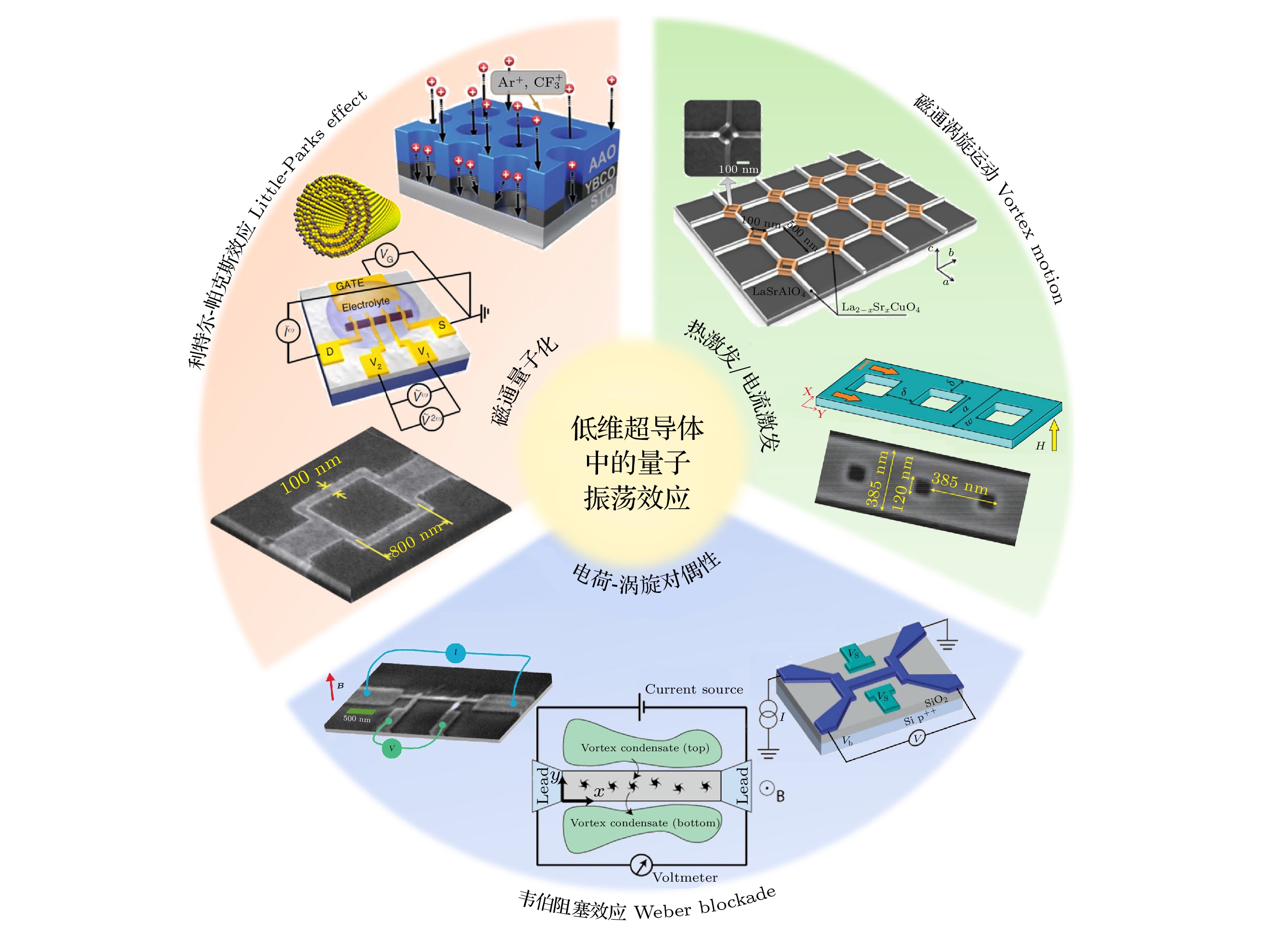
 下载:
下载:
